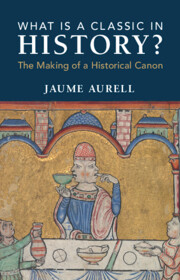Book contents
- What Is a Classic in History?
- What Is a Classic in History?
- Copyright page
- Contents
- Acknowledgements
- Introduction
- 1 The Conditions for Durability
- 2 The Dynamics of the Classic
- 3 The Inescapability of the Canon
- 4 The Canonical Function of Historical Genres
- 5 Genealogy as Double Agent
- Conclusions
- Selected Bibliography
- Index
1 - The Conditions for Durability
Published online by Cambridge University Press: 15 February 2024
- What Is a Classic in History?
- What Is a Classic in History?
- Copyright page
- Contents
- Acknowledgements
- Introduction
- 1 The Conditions for Durability
- 2 The Dynamics of the Classic
- 3 The Inescapability of the Canon
- 4 The Canonical Function of Historical Genres
- 5 Genealogy as Double Agent
- Conclusions
- Selected Bibliography
- Index
Summary
When we think in terms of the durability of historical texts, some works instantly come to mind: Herodotus’, Thucydides’, and Polybius’ war narratives, Edward Gibbon’s Decline and Fall of the Roman Empire, Jules Michelet’s History of France, Jacob Burckhardt’s The Civilization of the Renaissance in Italy, Johan Huizinga’s The Waning of the Middle Ages, Fernand Braudel’s Mediterranean, and Edward Thompson’s The Making of the English Working Class, among many others. Historians instantly perceive them as durable texts, part of a canon of history and historiography. I examine in this chapter the conditions that might be considered necessary for historical writing to achieve durability, justify why some historical texts have the potential for durability, propose what conditions of creation and reception enabled this longevity, and discuss what practical lessons we obtain from this inquiry. I begin making some distinctions among the three related concepts of durability, the classic, and the canon. I then try to establish the specific conditions of durability of historical texts, focusing on the concepts of Chronotope (Mikhail Bakhtin), the effect of contemporaneity (Gadamer and Koselleck), temporalization (Heidegger, Ricoeur), timelessness (Hartog), and the connections between the concepts of durability and the practical past (Oakeshott, Hayden White).
Keywords
- Type
- Chapter
- Information
- What Is a Classic in History?The Making of a Historical Canon, pp. 44 - 86Publisher: Cambridge University PressPrint publication year: 2024

